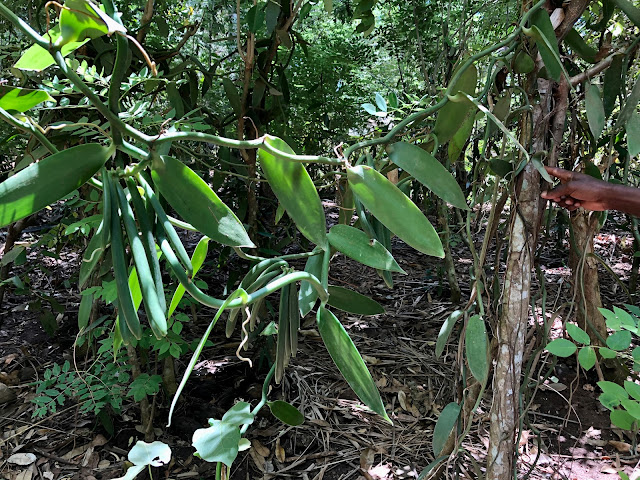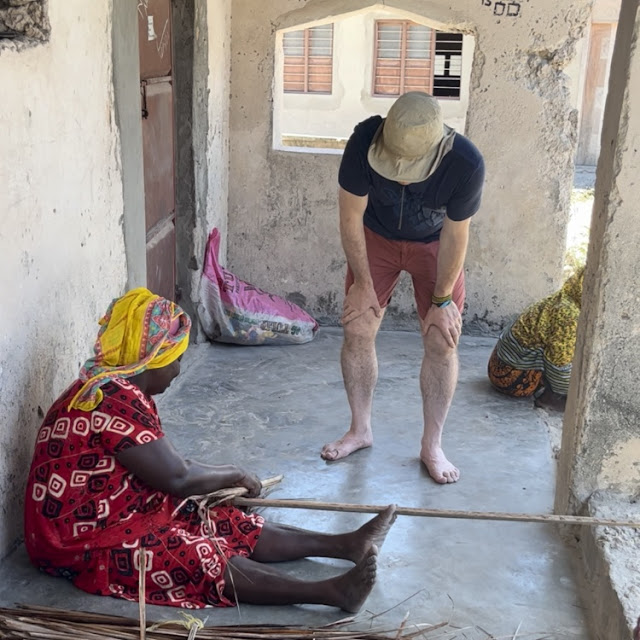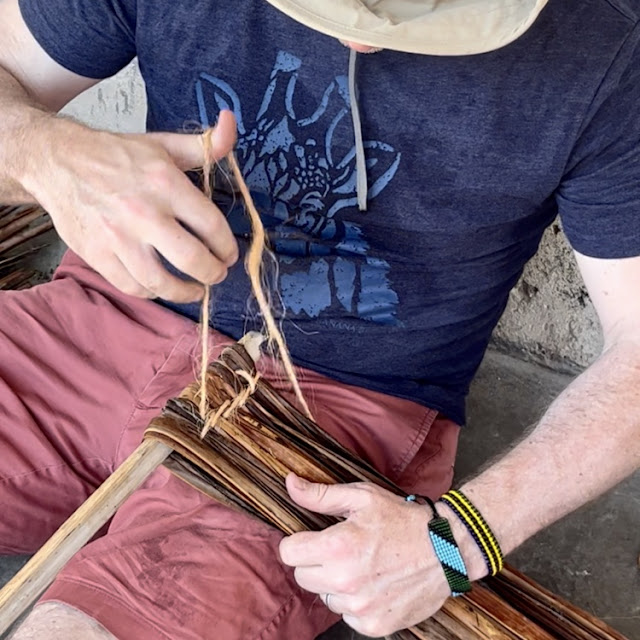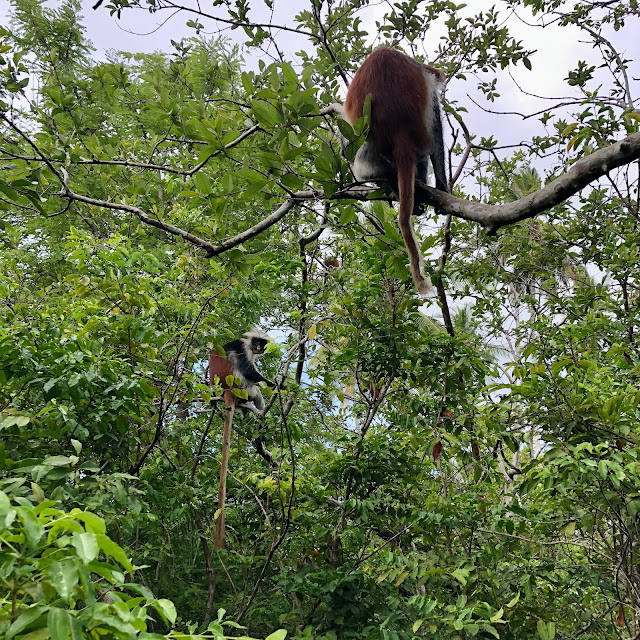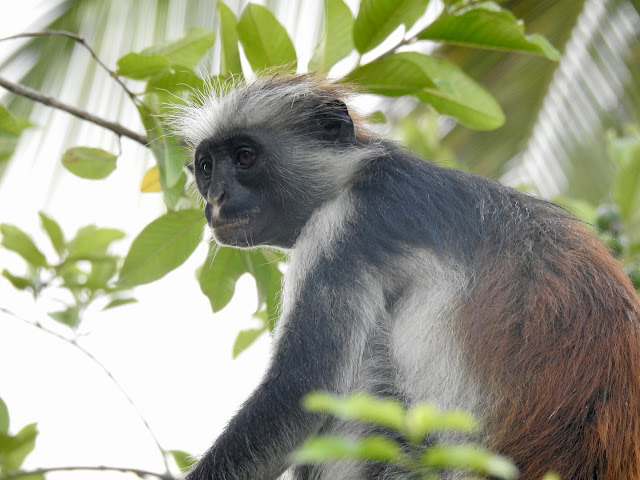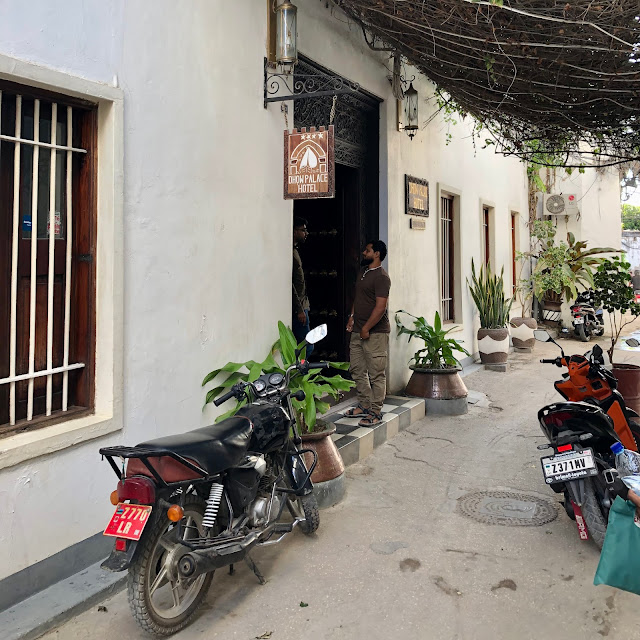Our safari trip to Uganda was precisely what it was planned to be and exactly what it needed to be. It consisted of three daytrips focused on single species (shoebills, chimpanzees and gorillas) along with three what I'll call "traditional" safaris, half day or so excursions into a national park to see what kinds of animals we could find with no specific species focus. Two of those traditional safaris were on land and the third, which turned out to be the most memorable of three, was on a boat. We couldn't really have asked for much more from our time in Uganda. Well sure, we could nitpick about nature not cooperating on one of the three safaris, but what would be the point?
With our passage out of Uganda and onto the islands of Zanzibar, the safari portion of our Africa 2023 trip was largely over. But largely over is not completely over and Zanzibar had an incredible surprise for us. We may have just left one of the best primate-spotting spots on the planet in Uganda but we didn't see monkeys in mainland Africa anything like we found waiting for us in Zanzibar's Jozani Forest. Our African wildlife watching in 2023 was not over after Uganda. Not even close.
One of the first places we put on our Zanzibar list after we firmed up our plans to spend a few nights there was the Jozani Forest. Jozani is literally the only place on land where we were guaranteed quality wildlife sightings on the island. The focus here was on red colobus monkeys with a few other species as possibles, including Sykes' monkeys. No elephants, no lions, no large mammals or sizeable birds at all here. It would be mostly about the monkeys in Jozani.
I know I used the word guaranteed in the previous paragraph in regards to finding wild animals in nature. I also know I shouldn't. But I feel like this excursion was a sure thing. There's only so many places this many monkeys can hide. This was a sure thing. No foreshadowing or tricks here. No questions asked. No strings attached. A sure thing.
Why a sure thing? Well, quite simply, and I'm guessing here a bit (but not much), there's not a whole lot of forest left on Zanzibar but there are a whole lot of monkeys. To its credit, having erased most of the animals' habitat, the island has sort of banded together to preserve these monkeys (and other forest residents) as a natural resource. There is one road which passes through the forest and every time we passed through there (including at about 4:30 in the morning the day we departed), there were police forcing traffic to slow to a tortoise-like crawl to prevent any on-road casualties. As an added measure of insurance to prevent human-on-monkey crime, the government has agreed to compensate neighboring villagers for any crop damage caused by the monkeys.
 |
| Red colobus monkey (top) and Sykes' monkey (bottom). |
For its size (which is about 50 square kilometers), the Jozani Forest is quite diverse. There are at least three distinct and separate environments within the forest: an old growth forest established on top of a former coral bed; a mangrove forest; and a super large grove of fruit trees, mostly guava and almond. We spent time walking through all three and while the old growth forest and the mangroves were picturesque and very scenic, they offered little in the way of wildlife, which, you know, is kind of what we were there to see.
Now, sure, the mangroves got us a sighting or two of the less common Sykes' monkeys and some very cool and funky red and black crabs crawling over the dense soil at the base of the forest. We also spotted a couple of Sykes' monkeys around the perimeter of the old growth forest. But the star attraction here was the red colobus monkeys, which almost without exception we found in the guava trees. And to say we found them is really an understatement. We found a ton of them. So many, in fact, that we ended up spending between the three environments, about three and a half hours total roaming around the forest. Not a typo. There was a ton to see. I told you this was a sure thing, didn't I?
And when I said that the old growth forest was on top of a former coral bed, I was serious. There were spots on our walk where we were literally walking on top of worn down coral. Not stone. Coral. If our guide, Mohammed, hadn't have pointed this out, I wouldn't have even considered that we were walking over the top of something that used to be under the Indian Ocean. Although I suppose it wasn't called the Indian Ocean at that point in time.
 |
| Old growth forest (top) and mangroves (bottom). |
We had caught glimpses of red colobus monkeys in our time in Uganda the week before we arrived in Zanzibar. I mean fleeting glimpses between tree branches from far away. Nothing of any sort of quality. The Jozani Forest got us all the time we needed with these animals. Enough time to talk with both our guides, both of whom were called Mohammed, and look and watch and observe.
The red colobus is for sure a distinct looking monkey. They obviously get their red name from the rust red color on their backs but that's not where the characteristics that define this species stop. First, they have extremely long tails. We've see all sorts of monkey species all over Africa and in Central America but I don't think we've seen tails quite like the red colobus have. Maybe it's the way they sit in trees with their bodies scrunched up together and their tails dangling straight down. It's almost like the tail is about three times the length of their bodies. It's not, by the way, but sometimes it seems that long.
They also have just four fingers. This is a little unbelievable at first. I mistakenly thought that all monkeys have five fingers with opposable thumbs. They don't. Not all of them. Not the red colobus. No thumbs. None. We managed to get so close to these creatures to be able to check this out in person. That means they stayed still long enough in person right in front of us for us see for ourselves and then point it out to each other while the monkey was still right there about four feet away.
But if there's a feature of these primates that make them irresistible, it's their haircuts. I don't mean that literally of course. There are no red colobus barbers in the Jozani forest but they all seem to have the same 'do, hair brushed straight back from their forehead and sticking straight up and out. They are for sure the punks of the animal kingdom.
We started our day in Jozani early. It's the best time to see wildlife, after all. Before the day gets too hot. We headed straight into a grove of guava trees and looked, walked and waited. In really short order, our search was rewarded. Red colobus monkeys travel in troops as large as 30 and with their protected status on the island, it's easy to grow a group to that size. Once one starts hanging around in a guava tree, it's followed by another and another and then maybe a half dozen or ten or more.
Red colobus monkeys can't process sugar so they love yellow guava, fruit that hasn't matured and developed the full sugary content of a fully ripe fruit. So find a stand of trees with unripened guava in the Jozani Forest early in the morning and you are likely guaranteed a sighting of a significant quality and length. Large troops of monkeys looking for food in the morning are active and their ages range the from the very young babies still clinging to their mothers to the eldest monkeys. Young monkeys means playing and jumping and swinging and lots of being active. And active wildlife watching is way better than animals milling around doing nothing much.
These monkeys must see human tourists every day. That kind of audience and the fact that the locals don't chase them off based on their agreement with the Zanzibari government makes them extremely habituated to humans. We didn't see any fear or any aggression during our walk in the guava trees. I even had two monkeys at various points in the day walk within a foot of me, including one in the guava grove who pretty much pushed past me on a trail like I was just an object preventing him (assuming gender, here) from getting from point A to point B. The second occasion was a mother with baby, which was special to see. It's clear they don't care about humans if they are willing to walk right past you with an infant.


I am a firm believer in the value of actually traveling in person and just being somewhere far away from home and experiencing something you can experience nowhere else on our planet. I am sure there are people out there who think that you can probably simulate a lot of travel experiences by strapping on a virtual reality headset and seeing what's on the screen and hearing what's coming at you through the speakers. But there's more to travel than sight and sound. If there's a recent experience that emphasized that fact to me, it was our trip to Jozani.
It's the smell.
When you are walking through those trees looking for (and finding) monkeys, the smell of guava is everywhere. It's overpowering in its sweetness. It's completely wonderful. It's a smell from that day that I will never, ever forget. It was so powerful and I am sure any smell of guava will take me back there instantly.
Why is it so strong? Honestly, because the red colobus is a bit of a messy eater. They are prone to taking a few bites of a fruit and then just dropping it right on the ground. And when tourists like me go stomping around in their Timberlands squashing these discarded monkey half-meals it just amplifies the aroma. It's so strong that when we were traveling back to the airport from our stay on the east coast of Zanzibar and we passed through the forest, we could smell the fruit through the open car windows. I'm telling you, there's value in actually being there.
By the way...if you are walking through the forest looking for monkeys, watch out for falling guavas. There are definitely heftier fruit out there but getting clunked on the noggin is definitely a surprise. Trust me, I know from experience. It's not a papaya or a coconut or anything like that, but just watch out.
I have frequently used the word intimacy to describe our encounters with wildlife on this trip. Spending moments or longer than moments feet from a chimpanzee or a gorilla or even a colobus monkey is truly an intimate experience. The chance to get this close to a wild animal and have it be ok with you and you be totally cool just standing and watching is just amazing. I hate to be so generic in my description of this experience but honestly there's an intelligent being doing what it's doing mere feet or yards away from you and you are both just in the moment. It's something that has to be experienced.
This day was for sure the best monkey encounter I've ever had. There were tons, they weren't concerned about our presence, they were active, they were close and they didn't attack. That last one I feel is particularly important. Every time you go out into nature to try to see something, it's a bit of a crap shoot (I'm not suggesting here realistic odds of being attacked by an animal, by the way). You never know what you are going to get. This one got us something spectacular.


One more thing...we didn't just settle for monkeys on this trek. There were other animals to seek out in the Jozani Forest. When you first get to the park, there are a couple of giant animal spotting boards for the first time visitor to look at and assemble a wish list. Mongoose, wild pigs, duikers, civets, African wood owls, turacos and much, much more. They are all just way harder to spot than those red colobus monkeys because quite frankly there are just far fewer of them and they are not drawn to the guava trees every morning in huge groups.
We tried for a duiker or two. There's a fenced in section of the park that holds these small deer. We walked a bit of the perimeter of the fence and saw nothing. The fence is there to prevent these animals getting out onto the road and getting killed by a car. From a nature-seeking tourist perspective, the fence also prevented us from walking through that section of the park to flush one out. No big loss here. We can see deer at home.
But we did manage a look at an elephant shrew. It was fleeting, it was far away and it was gone before I could take a picture but this was a thrill just the same. When else am I realistically going to see an elephant shrew? Shrews are one of the tiniest mammals out there, they have to be fairly difficult for humans to spot and they have to be fairly tasty for other animals to eat. Now, granted, the elephant shrew is huge compared to most shrews (hence the "elephant" part of the name, which also I suppose refers to its long nose that sort of resembles a trunk) but it's still got to be pretty hard to find in the wild. I suppose the almost complete lack of predators that can find these things under a tree canopy helped a lot.
We spent most of our days in Zanzibar at our hotel on the beach fronting the Indian Ocean on the east side of the island. But we took a day trip per day each morning and every one of them was worthwhile. This one got us the most animals. Total success.
 |
| One of the two animal boards. Elephant shrew is bottom center. |
For our final four nights in Africa, we stayed on the east coast of Zanzibar at the Uzuri Villa, a six room hotel in Jambiani fronting right onto the Indian Ocean. We spent most of our time those last three full days at the hotel just hanging out on the hotel property which was pretty much a version of paradise.
Each day, we took at least one quick trip out of the hotel, either arranged through the hotel or through Viator.com, which I find is a good ideas repository for things to do when we are out of town. We don't always book through Viator when we find something there but we did in this case. We picked the Jozani National Park tour through Mo Tours & Safaris. "Mo" I assume here is one of the two Mohammeds who accompanied us on our tour. We picked this tour because they were willing to pick us up from our hotel in Jambiani even though they are based out of Stone Town on the complete opposite side of the island (the island may seem small but it's at least an hour to get across it).
Honestly, both our guides were awesome. They clearly got us some great looks at all sorts of monkeys, they gave us lots of great information and when we found a small troop of red colobus along the side of the road after we'd finished our walk through the forest, they stopped and let us watch this group for 20 minutes or so. The tour time on their Viator page says three hours. We spent more than that in the Jozani Forest. Our total tour time was probably closer to 4-1/2 total. I'd highly recommend these guys.



